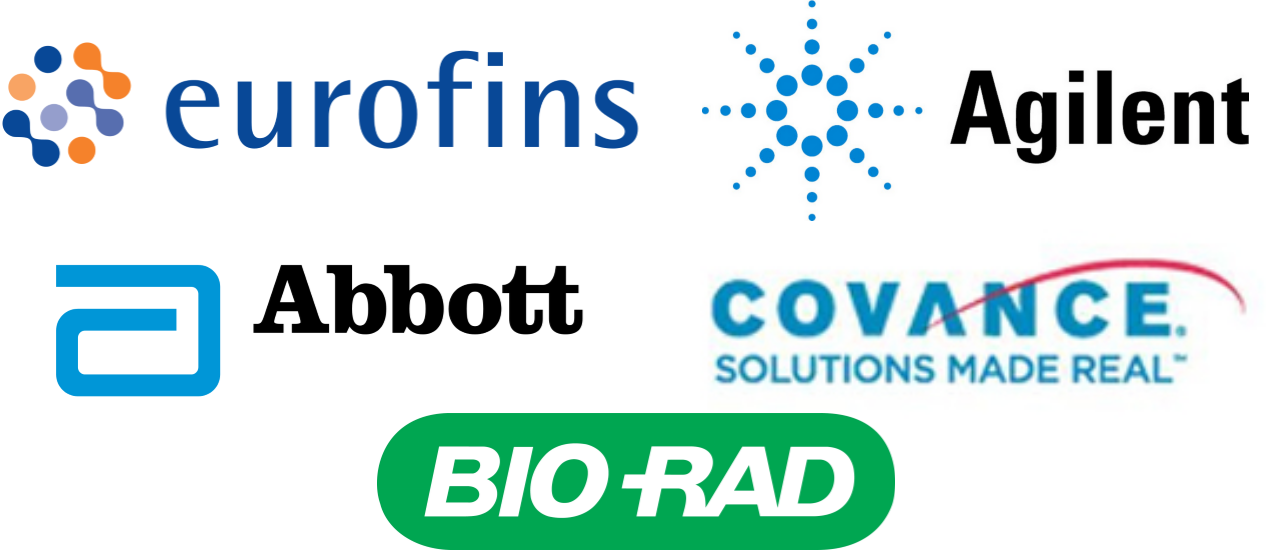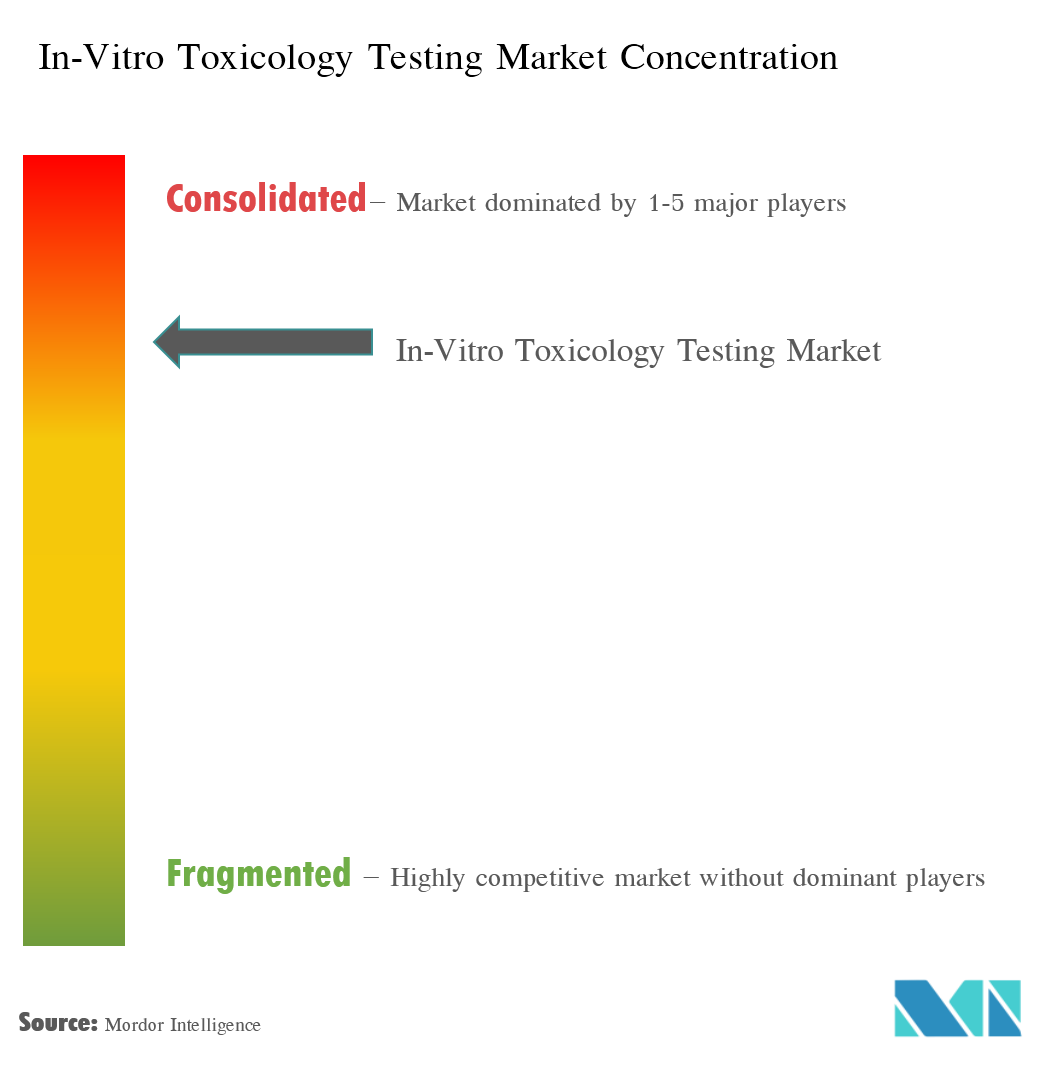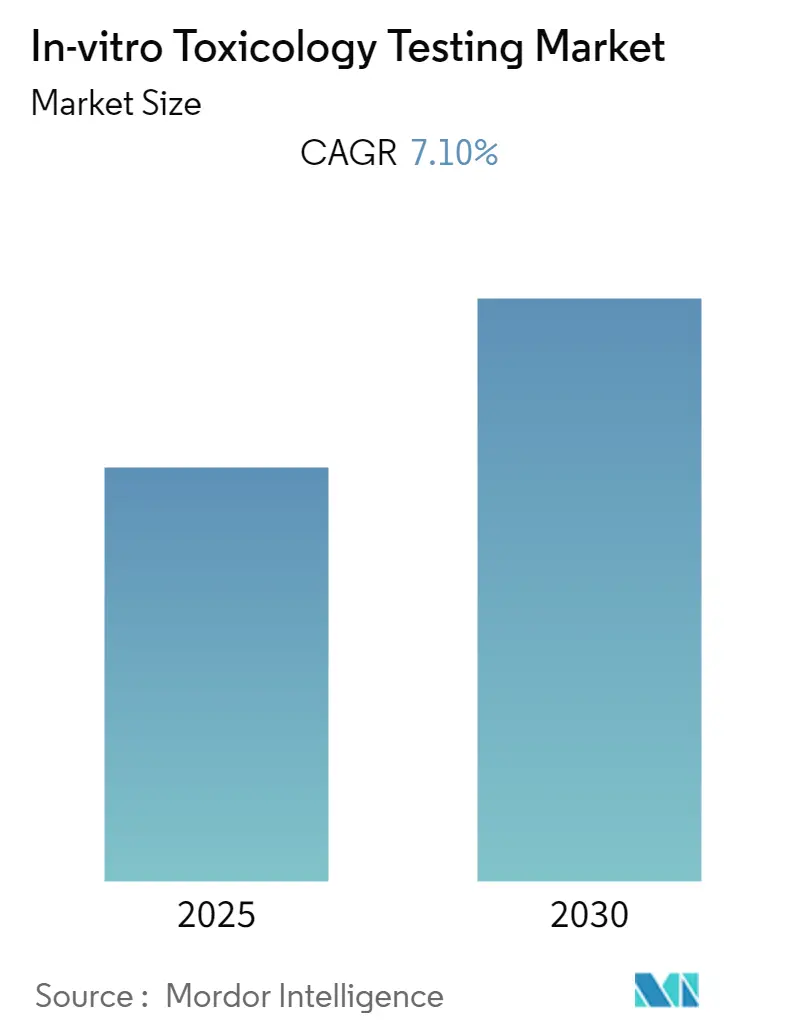
In Vitro Toxicology Testing Market Analysis
The In-vitro Toxicology Testing Market is expected to register a CAGR of 7.1% during the forecast period.
In-vitro tests provide toxicity information in a cost-effective and timesaving manner. It is anticipated that rapid advances in biomedical sciences will result in the development of newer and advanced in-vitro test strategies for hazard characterization. Toxicity testing is slowly becoming proficient with various advanced technologies aiding the process. It is currently poised to take advantage of promising revolutions from the field of biotechnology. The applications of toxicity testing are set to increase with advances in biotechnology, resulting in a demand for the same in the market. The advances in toxicity testing practices, such as bioinformatics, computational toxicology, epigenetics, etc., hold the potential for a paradigm shift from whole-animal testing to in-vitro methods that evaluate changes in various processes, which use cell lines and other cellular components. A number of emerging fields and techniques are contributing major new insights for understanding biologic responses to chemicals in human tissues. These advances are expected to drive the growth of the in-vitro toxicology market during the forecast period.
However, the screening process is quite stringent for the approval of any healthcare molecule. Many molecules fail in the toxicity study stage and are barred from entering the market. In-vitro toxicology testing as an alternative to animal testing is by default always under the lens, as it is intended to replace a fully approved method for toxicity study (animal testing). This is because in-vitro toxicology testing has to match closely to the standards from in-vivo animal testing. Regulators, including the United States Food and Drug Administration (FDA), have issued guidance with regard to in-vitro studies to be conducted during drug development.
However, current regulatory guidance does not address specific study designs for in-vitro toxicity testing. The experimental procedures and documentation of data for in-vitro testing should be rigorous, reproducible, with specific analytical methods, along with documentation of assay procedures and results. Therefore, these stringent regulations are restraining the growth of the in-vitro toxicology testing market, globally. Other factors, such as incapability of in-vitro models to determine autoimmunity and immunostimulation, are also acting as major restraints for the market studied.
In Vitro Toxicology Testing Market Trends
Cell Culture is Expected to Hold Significant Market Share in the Technology Type
Recent inventions and advances in human cell culture exposure, as well as test systems, have allowed the expansion and development of in-vitro assay systems, which are predictive, demonstrative and suitable for toxicity screening of a varied range of chemicals including nanomaterials and airborne materials.
In-vitro toxicology involves using cells or tissues grown or maintained in a controlled laboratory environment to examine the toxic properties of various compounds and mixtures. This further enables one to examine the toxicity of xenobiotics at the basic level of the cell without involving the interplay of complex physiological systemic effects, which are often observed in entire organisms.
However, definite cellular functions could be studied with primary cell cultures obtained from specific tissues such as the kidney or gills for ionic homeostasis, liver for xenobiotic biotransformation, and the nerve cells for neurotransmitter signaling effects.
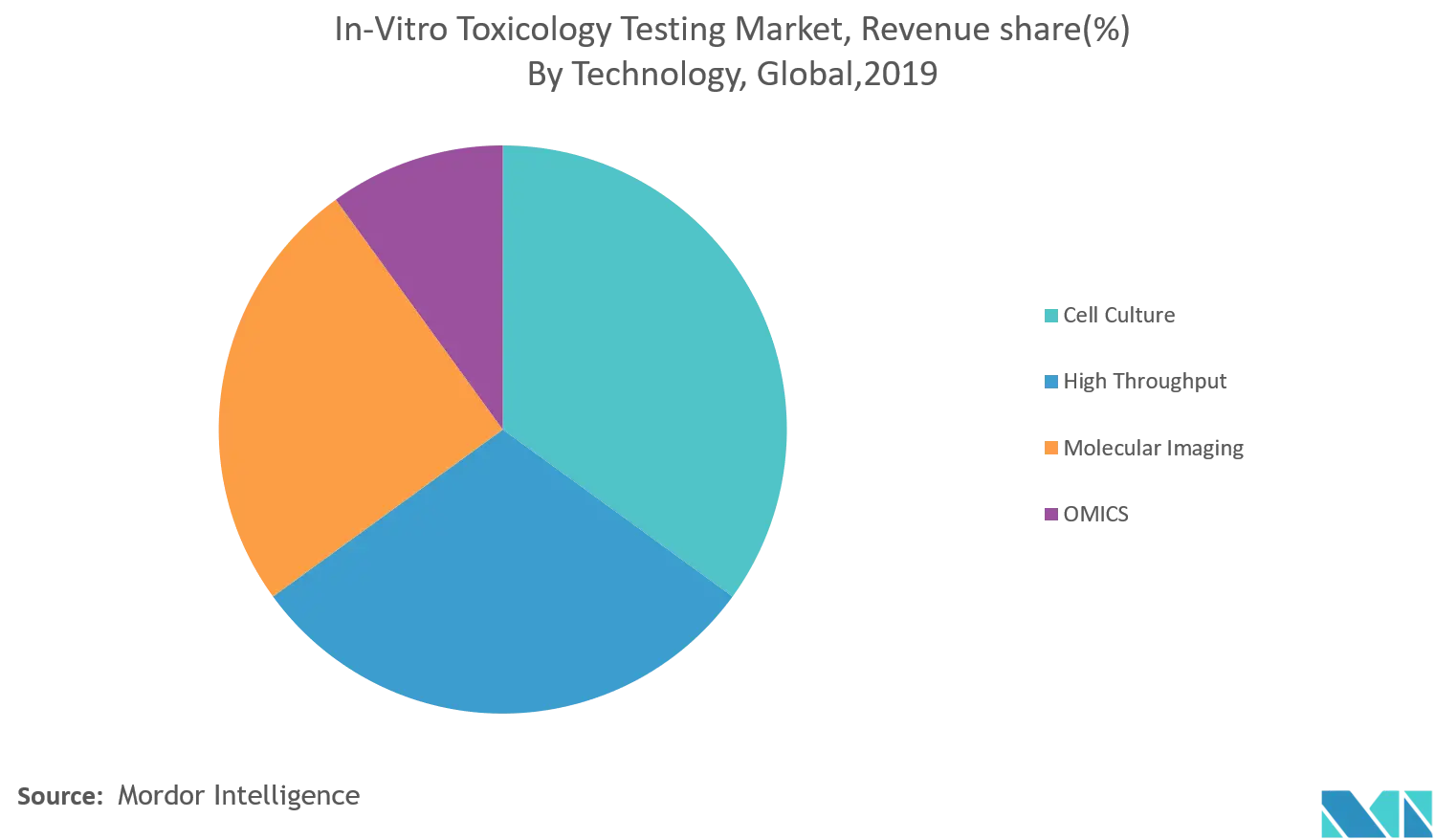
North America Dominates the Market and is Expected to Do So in the Forecast Period
Over the past few years, technical advancements and supportive government regulations have led to the rapid development of innovative, cost-effective testing for establishing drug, device, chemical and cosmetic safety, in North America. The significant increase in investment in instruments and the ongoing expansion of laboratory capabilities, across the region, currently, enable clients to establish toxicological profiles of medical devices, biopharmaceuticals, cosmetics, and chemicals. These investments include an expansion of the existing cell/tissue culture capabilities, flow cytometry, and mass spectrometry facilities, apart from the introduction of high throughput screening, automation, and multiplexing technologies for biomarker analysis.
The Asia Pacific region is estimated to witness the highest growth rate owing to the increasing focus of government organizations to promote toxicology testing by in-vitro methods. Moreover, conducting clinical trials in Asian countries is relatively cost-effective when compared to western nations, owing to which several biopharmaceutical companies perform their drug development procedures in this region.
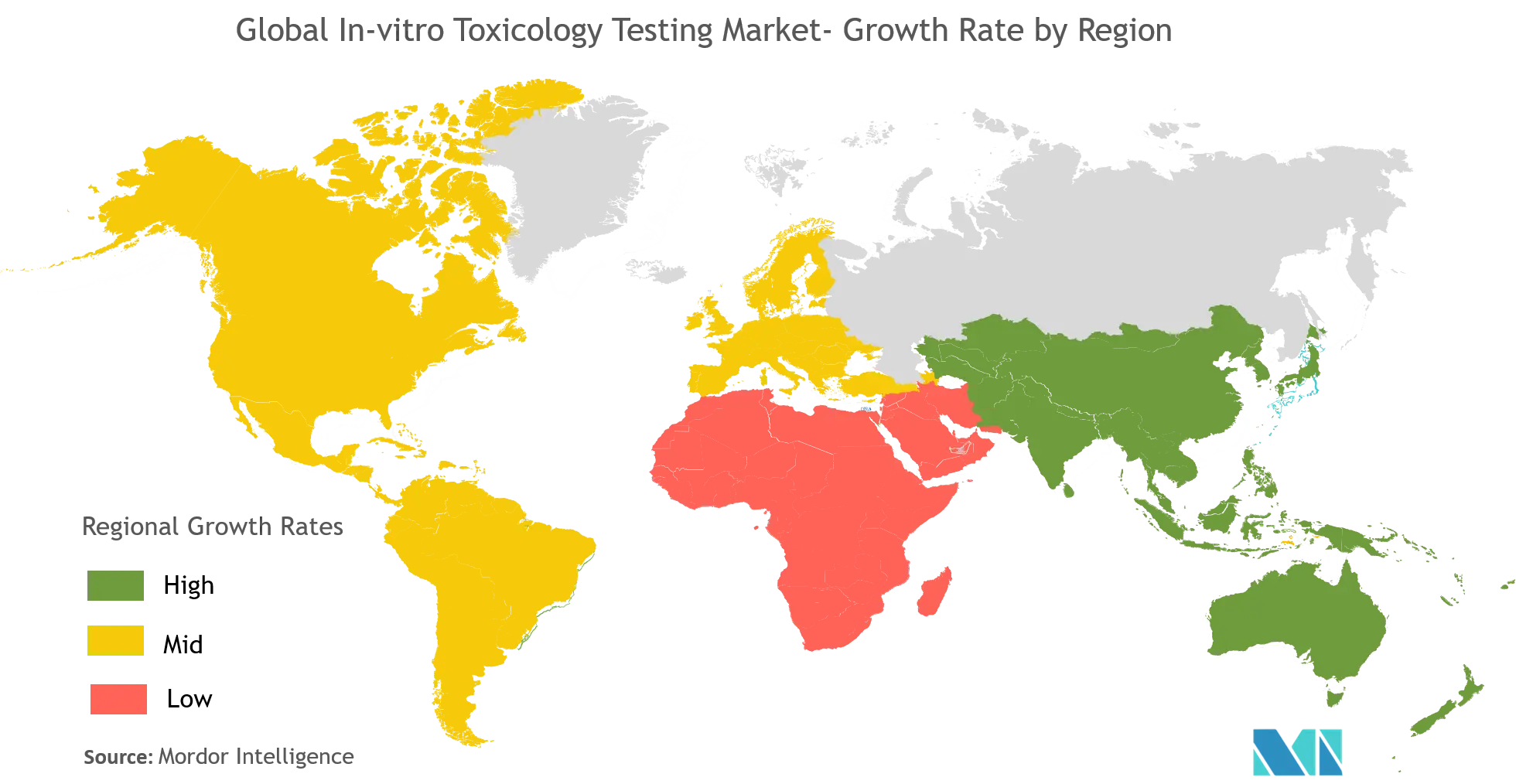
In Vitro Toxicology Testing Industry Overview
The in-vitro toxicology testing market is highly competitive and consists of a few major players. Companies, such as Abbott Laboratories, Agilent Technologies, Bio-Rad Laboratories, Covance, Eurofins Scientific, GE Healthcare, Merck KGaA, Promega Corporation, Quest Diagnostics, and Thermo Fisher Scientific, among others, hold a substantial market share in the market studied.
Market entities are also engaged in expanding their market presence by entering untapped regions and collaborating with other smaller manufacturers that offer in-vitro assays. For instance, in August 2019, Abbott signed an agreement with Intoximeters, which gave Intoximeters exclusive distribution rights to Abbott's SoToxa Mobile Test System, a handheld oral fluid solution for drug and alcohol testing in the U.S. The product enables the testing of methamphetamine, benzodiazepines, amphetamine, cocaine, cannabis (THC), and opiates.
In Vitro Toxicology Testing Market Leaders
-
Abbott Laboratories
-
Bio-Rad Laboratories
-
Covance
-
Agilent Technologies
-
Eurofins Scientific
- *Disclaimer: Major Players sorted in no particular order
In Vitro Toxicology Testing Industry Segmentation
In-vitro toxicity testing is referred to the method of scientifically analyzing the effects of lethal or toxic chemical materials either on mammalian cells or on cultured bacteria. In-vitro testing methods are performed mainly for the purpose of identifying potentially harmful chemicals and/or for confirming the deficiency of certain toxic properties in the initial stages of the development of possibly useful novel substances, including therapeutic drugs, agricultural chemicals, and even food additives.
| By Technology | Cell Culture | ||
| High Throughput | |||
| Molecular Imaging | |||
| OMICS | |||
| By Method | Cellular Assay | ||
| Biochemical Assay | |||
| In Silica | |||
| Ex-vivo | |||
| By Application | Systemic Toxicology | ||
| Dermal Toxicity | |||
| Endorine Disruption | |||
| Occular Toxicity | |||
| Other Applications | |||
| By End User | Pharmaceutical and Biotechnology | ||
| Diagnostics | |||
| Other End User | |||
| Geography | North America | United States | |
| Canada | |||
| Mexico | |||
| Europe | Germany | ||
| United Kingdom | |||
| France | |||
| Italy | |||
| Spain | |||
| Rest of Europe | |||
| Asia-Pacific | China | ||
| Japan | |||
| India | |||
| Australia | |||
| South Korea | |||
| Rest of Asia-Pacific | |||
| Middle-East & Africa | GCC | ||
| South Africa | |||
| Rest of Middle-East & Africa | |||
| South America | Brazil | ||
| Argentina | |||
| Rest of South America | |||
In Vitro Toxicology Testing Market Research FAQs
What is the current In-vitro Toxicology Testing Market size?
The In-vitro Toxicology Testing Market is projected to register a CAGR of 7.1% during the forecast period (2025-2030)
Who are the key players in In-vitro Toxicology Testing Market?
Abbott Laboratories, Bio-Rad Laboratories, Covance, Agilent Technologies and Eurofins Scientific are the major companies operating in the In-vitro Toxicology Testing Market.
Which is the fastest growing region in In-vitro Toxicology Testing Market?
Asia Pacific is estimated to grow at the highest CAGR over the forecast period (2025-2030).
Which region has the biggest share in In-vitro Toxicology Testing Market?
In 2025, the North America accounts for the largest market share in In-vitro Toxicology Testing Market.
What years does this In-vitro Toxicology Testing Market cover?
The report covers the In-vitro Toxicology Testing Market historical market size for years: 2019, 2020, 2021, 2022, 2023 and 2024. The report also forecasts the In-vitro Toxicology Testing Market size for years: 2025, 2026, 2027, 2028, 2029 and 2030.
Our Best Selling Reports
In Vitro Toxicity Testing Industry Report
Statistics for the 2025 In-vitro Toxicology Testing market share, size and revenue growth rate, created by Mordor Intelligence™ Industry Reports. In-vitro Toxicology Testing analysis includes a market forecast outlook for 2025 to 2030 and historical overview. Get a sample of this industry analysis as a free report PDF download.

